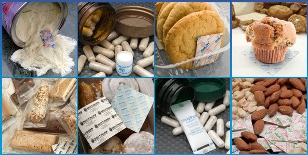
A Q& A with Bob Sabdo, market leader – North America Food & Beverage Packaging, Multisorb Technologies about sorbent technology and its benefits.
Food and Beverage Packaging: What is sorbent technology?
Bob Sabdo:Sorbent technology is a form of active packaging, which continuously modifies the packaging headspace to keep it in a preferred state, maintaining food’s quality and extending its shelf life. Sorbent technology is dynamic - actively removing or emitting a particular substance, such as moisture, oxygen, or other gases. In comparison, other methods such as gas flushing are static and do not respond to changes to in the internal packaging environment.
Oxygen is one of the biggest threats to the longevity of food products. Oxygen, both in the product packaging and that which ingresses through permeable packaging over time, will promote the rancidity of fats, growth of aerobic organisms, loss of nutritive values, and loss of colors and flavors. The use of an oxygen absorber, such as our FreshPax® packets, FreshCard®, or FreshMax® self-adhesive absorbers can protect the quality profile of your food products.
Our oxygen absorbers contain food grade, inert ingredients that are sealed inside gas- and moisture-permeable packets, embedded into permeable card stock, or combined with a polymer to safely remove oxygen from the product packaging.
Unlike oxygen, removing moisture completely might not be the best solution. For some products like crackers using a desiccant to keep them crisp is beneficial, but other products, such as cakes or cookies, may require moisture regulation to maintain product’s texture and mouthfeel. Moisture regulating sorbent technology establishes and maintains a desirable equilibrium relative humidity within the packaging, which matches the water activity of the food product. Moisture that is released or absorbed from the sorbent keeps the food product at a consistent moisture level. Controlling moisture limits moisture-mediated degradation and preserves the appearance and flavor characteristics of the food, extending shelf life.
For products, such as nutritional supplements, where strong odors can impact consumer acceptance, our sorbents can be formulated absorb odors as well as remove oxygen and/ or regulate moisture.
Sorbent technology is only useful when it fits the needs of our customers. We have listened to the brand owners, who want to have format choices it terms of implementing sorbent technology, and have provided an expansive line of Drop-In, Fit-In, and Built-In technologies.
A Drop-In solution consists of an optimized sorbent in the form of a packet that is dropped directly into the food package. Fit-In sorbent solutions are custom manufactured to a particular shape and size to fit into a device or packaging. This could take the form of a support card or a self-adhesive sorbent that attaches securely to the inside of the packaging. And finally, built-In sorbent solutions integrate sorbent technology into a molded part or packaging film. The format options we provide give our customers a higher level of flexibility than they will find anywhere else.
FBP:What are the benefits to using it?
Sabdo: There are many benefits to using sorbent technology: retention of color and flavor, extended shelf life, extended distribution potential, sustainability, which all contribute to the protection of brand integrity.
Color is one of the most important factors that influence consumer’s buying decisions. Color degradation in cured meat products, for example, is caused by photoxidation. This light activated free radical reaction can be slowed considerably by removing the oxygen before the product is placed in a lighted retail display case. FreshMax has been shown to reduce oxygen in packaged sliced ham to approximately 0.1% in 36–48 hours and to less 0.01% shortly thereafter. Under retail lighted display conditions, use of our oxygen absorber can increase shelf life up to 21 day. When you compare that to the typical two to three days shelf life expected for deli meats in traditional packaging, the benefit is clear.
Additionally, flavors are protected. Oxygen permeating through a packaging that does not contain a sorbent will be metabolized by aerobic spoilage organisms, leading to the development of off-flavors within the first week or so after packaging. The use of our sorbent technology will protect the flavor of your food.
Another benefit is that the extended shelf-life achieved with sorbent technology allows manufacturers and processors to expand their distribution reach. Long distribution changes pose a challenge because packages may be stored and shipped in climates with varying temperatures and humidity levels. As temperatures fluctuate, so do the humidity levels within the packaging, damaging the product’s integrity. Sorbent technology allows the moisture to remain stable, regardless of the external environment. The extended shelf life allows the product more time in the distribution chain when necessary.
Sustainability is an important, but sometimes overlooked, benefit. Food losses from spoilage or the product going out-of-date at retail and consumer levels are staggering. The use of sorbent technology can assist manufacturers and processors reach sustainability goals through the reduction of food loss, reduction of packaging, elimination of environmentally unsound materials, and improvement of supply chain management.
Protecting your products means protecting brand integrity. Consumers expect products that taste, look, smell, and feel freshly made. The use of sorbent technology can ensure that products maintain the level of freshness with which they were packaged.

Sabdo: In addition to the benefits I mentioned, which in themselves have an impact on the industry, longer shelf-life leads to less waste and greater salability. If a customer is satisfied with a product, they are more likely to be a repeat customer. Ultimately, this translates to money saved by the processor or manufacturer and increased sales for the brand owner.
Using sorbent technology opens up new opportunities in the industry. For example, extended shelf life allows niche markets, such as small gourmet cookie manufacturers, to extend their distribution. Another example is seen with whole muscle meat processors. They are able to see up to 21 days of shelf life prior to it being placed on the retail shelf; this can allow them to create savings by having a centrally located processing facility, eliminating the need for facilities in multiple geographic locations.
FBP: How has this technology evolved?
Sabdo: There is science behind sorbent selection. Buying an off-the-shelf packet and dropping into your food packaging is most likely going to provide unfavorable results. Many sorbent manufacturers still take this approach. Food technology is changing, packaging methods are changing, and so sorbent technology and the approach to it must evolve as well.
We take a consultative approach. Using our Calculations through Operations ® program, we work directly with our customers to understand their product and their specific needs. For a sorbent to be sized correctly many factors must be reviewed, such as the product’s ingredients, the product’s water activity, the packaging configuration, the packaging material’s water vapor and/ or oxygen transmission rates, the packaging headspace, environmental conditions at packaging, desired shelf life, and distribution and storage conditions. All of these factors are unique for each product and are used to calculate the precise formula for the product.
The operations portion of Calculations through Operations refers to our sorbent systems. Systems are available for our entire line of strip and card format sorbents. We are the only sorbent supplier to provide strip format sorbents that run exclusively with our own custom built dispensers. This tightly integrated system provides proven reliability.
As I mentioned earlier, we listened to what the industry was requiring and our sorbent technology has evolved to offer manufacturers, processors, and brand owners flexibility through a choice of format options. The Drop-in, Fit-In, and Built-in options we offer are a direct result of the industry evolving and having new and unique needs.
Our R&D group developed the world's first self-adhesive oxygen absorber. FreshMax is ideal for high-value foods where oxygen absorption requirements are at levels below 50cc. Their flat, flexible format, with an ultra-thin, low-profile design, makes them seemingly invisible.
We have also developed a low profile card with built-in oxygen absorbing functionality that irreversibly removes nearly all oxygen from the product packaging. Freshcard’s value lies in its multifunctional capabilities. It can be printed in up to four colors, making it perfect for advertising or providing mandatory information - great for cross marketing products, providing nutrition information, offering coupons, or directing traffic to your website using a QR code. With FreshCard you will have greater consumer acceptance over more traditional formats because consumers will view it as product packaging and not as an oxygen absorber.
For invisible protection, we have developed technologies that integrate sorbent material into a polymer substrate to create a thermoformed packaging component or thin film or film layer. Essentially the packaging becomes the sorbent providing barrier protection for the food product.
Our R&D team follows industry trends closely and will continue to listen to the market so that we can identify its needs and provide innovative solutions.
Photo used by permission of Multisorb Technologies, Inc., together with its subsidiaries and affiliates, Copyright 2004-2011.

Recent Comments
Custom Boxes
You are right, this is very important before...
You can find many inspiration from Instagram app...
Check out Honista app
Great Article!